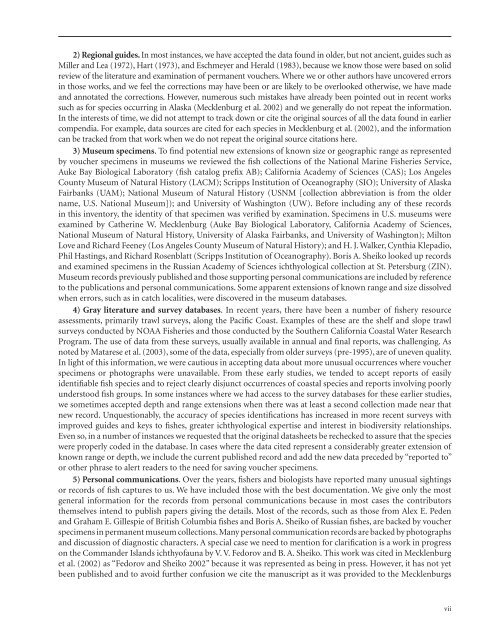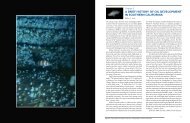checklist (pdf) - The Love Lab - University of California, Santa Barbara
checklist (pdf) - The Love Lab - University of California, Santa Barbara
checklist (pdf) - The Love Lab - University of California, Santa Barbara
You also want an ePaper? Increase the reach of your titles
YUMPU automatically turns print PDFs into web optimized ePapers that Google loves.
2) Regional guides. In most instances, we have accepted the data found in older, but not ancient, guides such as<br />
Miller and Lea (1972), Hart (1973), and Eschmeyer and Herald (1983), because we know those were based on solid<br />
review <strong>of</strong> the literature and examination <strong>of</strong> permanent vouchers. Where we or other authors have uncovered errors<br />
in those works, and we feel the corrections may have been or are likely to be overlooked otherwise, we have made<br />
and annotated the corrections. However, numerous such mistakes have already been pointed out in recent works<br />
such as for species occurring in Alaska (Mecklenburg et al. 2002) and we generally do not repeat the information.<br />
In the interests <strong>of</strong> time, we did not attempt to track down or cite the original sources <strong>of</strong> all the data found in earlier<br />
compendia. For example, data sources are cited for each species in Mecklenburg et al. (2002), and the information<br />
can be tracked from that work when we do not repeat the original source citations here.<br />
3) Museum specimens. To find potential new extensions <strong>of</strong> known size or geographic range as represented<br />
by voucher specimens in museums we reviewed the fish collections <strong>of</strong> the National Marine Fisheries Service,<br />
Auke Bay Biological <strong>Lab</strong>oratory (fish catalog prefix AB); <strong>California</strong> Academy <strong>of</strong> Sciences (CAS); Los Angeles<br />
County Museum <strong>of</strong> Natural History (LACM); Scripps Institution <strong>of</strong> Oceanography (SIO); <strong>University</strong> <strong>of</strong> Alaska<br />
Fairbanks (UAM); National Museum <strong>of</strong> Natural History (USNM [collection abbreviation is from the older<br />
name, U.S. National Museum]); and <strong>University</strong> <strong>of</strong> Washington (UW). Before including any <strong>of</strong> these records<br />
in this inventory, the identity <strong>of</strong> that specimen was verified by examination. Specimens in U.S. museums were<br />
examined by Catherine W. Mecklenburg (Auke Bay Biological <strong>Lab</strong>oratory, <strong>California</strong> Academy <strong>of</strong> Sciences,<br />
National Museum <strong>of</strong> Natural History, <strong>University</strong> <strong>of</strong> Alaska Fairbanks, and <strong>University</strong> <strong>of</strong> Washington); Milton<br />
<strong>Love</strong> and Richard Feeney (Los Angeles County Museum <strong>of</strong> Natural History); and H. J. Walker, Cynthia Klepadio,<br />
Phil Hastings, and Richard Rosenblatt (Scripps Institution <strong>of</strong> Oceanography). Boris A. Sheiko looked up records<br />
and examined specimens in the Russian Academy <strong>of</strong> Sciences ichthyological collection at St. Petersburg (ZIN).<br />
Museum records previously published and those supporting personal communications are included by reference<br />
to the publications and personal communications. Some apparent extensions <strong>of</strong> known range and size dissolved<br />
when errors, such as in catch localities, were discovered in the museum databases.<br />
4) Gray literature and survey databases. In recent years, there have been a number <strong>of</strong> fishery resource<br />
assessments, primarily trawl surveys, along the Pacific Coast. Examples <strong>of</strong> these are the shelf and slope trawl<br />
surveys conducted by NOAA Fisheries and those conducted by the Southern <strong>California</strong> Coastal Water Research<br />
Program. <strong>The</strong> use <strong>of</strong> data from these surveys, usually available in annual and final reports, was challenging. As<br />
noted by Matarese et al. (2003), some <strong>of</strong> the data, especially from older surveys (pre-1995), are <strong>of</strong> uneven quality.<br />
In light <strong>of</strong> this information, we were cautious in accepting data about more unusual occurrences where voucher<br />
specimens or photographs were unavailable. From these early studies, we tended to accept reports <strong>of</strong> easily<br />
identifiable fish species and to reject clearly disjunct occurrences <strong>of</strong> coastal species and reports involving poorly<br />
understood fish groups. In some instances where we had access to the survey databases for these earlier studies,<br />
we sometimes accepted depth and range extensions when there was at least a second collection made near that<br />
new record. Unquestionably, the accuracy <strong>of</strong> species identifications has increased in more recent surveys with<br />
improved guides and keys to fishes, greater ichthyological expertise and interest in biodiversity relationships.<br />
Even so, in a number <strong>of</strong> instances we requested that the original datasheets be rechecked to assure that the species<br />
were properly coded in the database. In cases where the data cited represent a considerably greater extension <strong>of</strong><br />
known range or depth, we include the current published record and add the new data preceded by “reported to”<br />
or other phrase to alert readers to the need for saving voucher specimens.<br />
5) Personal communications. Over the years, fishers and biologists have reported many unusual sightings<br />
or records <strong>of</strong> fish captures to us. We have included those with the best documentation. We give only the most<br />
general information for the records from personal communications because in most cases the contributors<br />
themselves intend to publish papers giving the details. Most <strong>of</strong> the records, such as those from Alex E. Peden<br />
and Graham E. Gillespie <strong>of</strong> British Columbia fishes and Boris A. Sheiko <strong>of</strong> Russian fishes, are backed by voucher<br />
specimens in permanent museum collections. Many personal communication records are backed by photographs<br />
and discussion <strong>of</strong> diagnostic characters. A special case we need to mention for clarification is a work in progress<br />
on the Commander Islands ichthy<strong>of</strong>auna by V. V. Fedorov and B. A. Sheiko. This work was cited in Mecklenburg<br />
et al. (2002) as “Fedorov and Sheiko 2002” because it was represented as being in press. However, it has not yet<br />
been published and to avoid further confusion we cite the manuscript as it was provided to the Mecklenburgs<br />
vii




